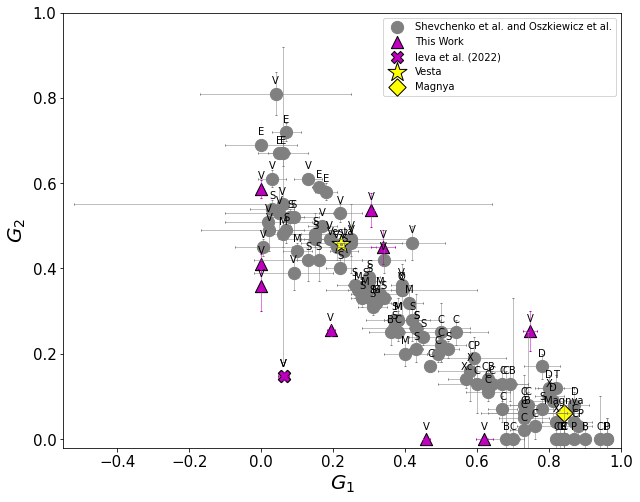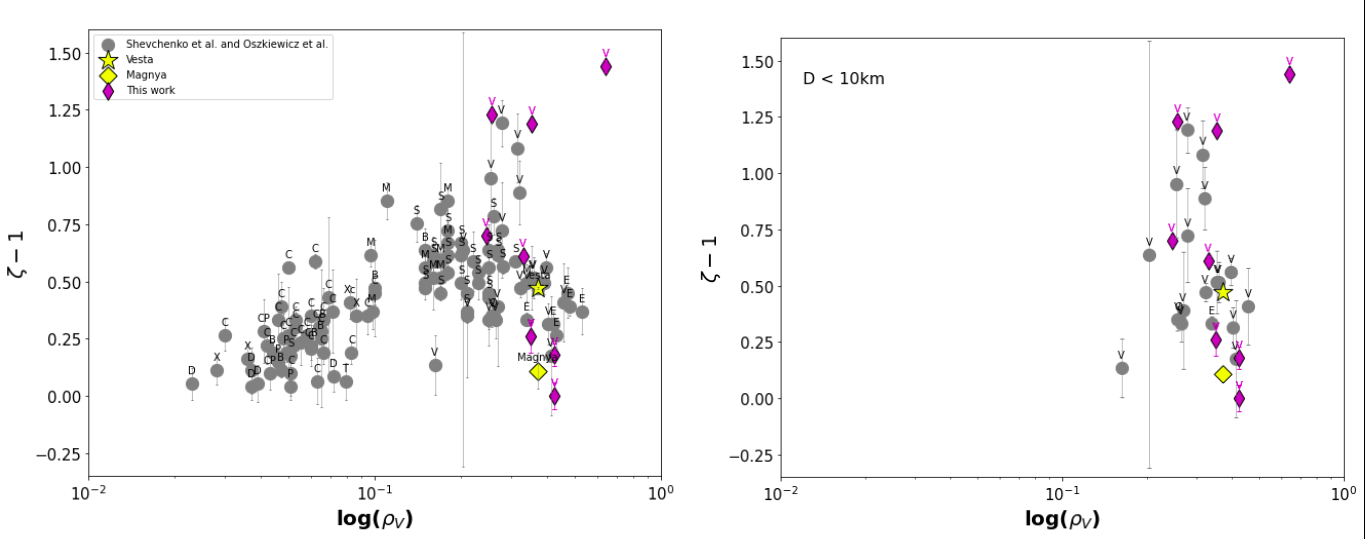Study of basaltic asteroids through their phase curves
- 1Observatório Nacional, Rio de Janeiro, Brazil (plicidaarcoverde@on.br)
- 2Instituto de Astrofísica de Canarias (IAC), La Laguna, Spain
- 3CONACYT - Instituto de Astronomı́a, Universidad Nacional Autónoma de México (IA-UNAM), Ensenada, Mexico
- Introduction
Classified as type-V, the basaltic asteroids of the Main Belt (MB), for the most part, are connected to Vesta's dynamic family. However, since the discovery of the V-type asteroid (1459) Magnya in the outer MB, several new asteroids have been found in different regions, including V-types from inner regions not belonging to the Vesta family. These findings suggest that these objects have more than one parental body and can sample multiple differentiated planetesimals, making them an interesting class to study.
Therefore, an interesting method for studying the surface properties of asteroids is through photometric phase curves, which are defined as the study of the scattering of light from a body according to the variation in the solar phase angle. Hence, to determine our phase curves, we use the three-parameter nonlinear model H-G1-G2 developed by Muinonem et al. (2010) and Penttilä et al. (2016), which provides us with the absolute magnitude (H), which is defined as the intrinsic brightness of the object and is related to size, and the curve slope parameters (G1-G2), which are related to surface properties.
- Observations and results
For this study, we selected ten V-types, nine MB asteroids and one NEO, with only one MB belonging to outer MB, (1459) Magnya. To achieve this, data from observations carried out between May 2014 and May 2020, was obtained at the Observatório Astronômico do Sertão de Itaparica (OASI, Brazil), within the framework of the IMPACTON project (Lazzaro et al., 2010).
To investigate the phase curve behavior of V-types, we first analyze the distribution of slope parameters in G(1) vs G(2) phase space for our sample of observed V-types compared to other data, as shown in figure 1. As it can be seen, this is a different result from that obtained by Oszkiewicz et al. (2021) which analyzing V-types in the inner main belt and found a clustering of objects around (4) Vesta. In our sample, some V-types cluster around (4) Vesta, in a region corresponding to objects with moderate to high albedo. Other objects, show a behavior more similar to (1459) Magnya, being located in the region displaying the highest concentration of objects of C-, P- and D-type. Moreover, a few objects, are found completely outside the correlation region. However, as shown by Arcoverde et al. (2023), for MB and NEO small objects, this spread along the correlation trend can be attributed to the small size of the analyzed V-types.
Then, we investigated the behavior of the phase curves in the OE region aiming to characterize their dependence on the object´s albedo. Figure 2 shows the distribution of the amplitude of OE 𝜻 - 1, according to the albedo of each object.

Figure 1: Distribution of slope parameters in phase space G1 vs G2 to observed asteroids. Data from this work and Ieva et al., (2022), indicated by magenta symbols, and Shevchenko et al., (2016) and Oszkiewicz et al., (2021) indicated by gray symbols, highlighting Vesta and Magnya for comparison.
Although all the observed V-type clusters at moderate to high albedo, differently from other taxonomic classes they span a large range of amplitude of the OE. Belskaya et al., (2000) found that the amplitude of the OE varies according to the combined effect of shadow hiding and coherent-backscatter mechanisms, with an increase in amplitude for objects with moderate albedo, and a decrease for those with low and high albedo. In this work, we found the same relationship, but only for large objects. The greatest variation in OE amplitude was found in small objects, diameter of around 10 km including (1459) Magnya (figure 2, right panel), suggesting that the size of the objects has influence on the surface distribution of the regoliths: larger objects are capable of containing finer regolith particles compared to smaller ones, and resulting in the distribution found.

Figure 2: The same distribution of the amplitude of OE 𝜻 - 1, according to the albedo same as Fig. 1. The left panel represents all objects, and the right panel the objects with D < 10km, highlighting Vesta and Magnya for comparison.
Finally, the results obtained here were determined based on high-quality data obtained at the OASI, reinforcing the importance of a dedicated telescope. Nevertheless, more observations of basaltic objects are necessary to better understand the behaviors presented here, especially for the smallest objects and focusing in high-quality phase curves with as much information as possible in the OE region.
Acknowledgements
P.A., E.R., F.M., M.E, W.P. and J.M. would like to thank CNPq, FAPERJ and CAPES for their support through diverse fellowships. Support by CNPq (310964/2020-2) and FAPERJ (E-26/202.841/2017 and E-26/201.001/2021) is acknowledged by D.L. The authors are grateful to the IMPACTON team, in special to R. Souza, A. Santiago and J. Silva for the technical support.
References
Arcoverde P., et al., 2023, MNRAS, 523, 739
Belskaya I. N., Shevchenko V. G., 2000, Icarus, 147, 94.
Ieva S., et al., 2022, MNRAS, 5313, 3104.
Lazzaro D., 2010, Boletin de la Asociacion Argentina de Astronomia La Plata Argentina, 53- 315.
Muinonen K., Belskaya I. N., Cellino A., Delbò M., Levasseur-Regourd A.-C., Penttilä A., Tedesco E. F., 2010, Icarus, 209, 542.
Oszkiewicz D., et al., 2021, Icarus, 357, 114158
Penttilä A., Shevchenko V. G., Wilkman O., Muinonen K., 2016, Planetary and Space Science, 123, 117.
How to cite: Arcoverde, P., Pereira, W., Rondón, E., Monteiro, F., Evangelista-Santana, M., Michimani, J., Medeiros, H., Silva-Cabrera, J., Rodrigues, T., and Lazzaro, D.: Study of basaltic asteroids through their phase curves, Europlanet Science Congress 2024, Berlin, Germany, 8–13 Sep 2024, EPSC2024-999, https://doi.org/10.5194/epsc2024-999, 2024.